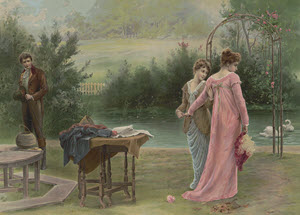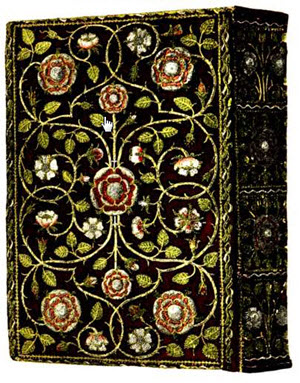PHILOSOPHY OF FURNITURE.
by Edgar Allan PoeIn the internal decoration, if not in the external architecture of
their residences, the English are supreme. The Italians have but little
sentiment beyond marbles and colours. In France, _meliora probant,
deteriora _sequuntur - the people are too much a race of gadabouts to
maintain those household proprieties of which, indeed, they have a
delicate appreciation, or at least the elements of a proper sense. The
Chinese and most of the eastern races have a warm but inappropriate fancy.
The Scotch are _poor _decorists. The Dutch have, perhaps, an indeterminate
idea that a curtain is not a cabbage. In Spain they are _all _curtains - a
nation of hangmen. The Russians do not furnish. The Hottentots and
Kickapoos are very well in their way. The Yankees alone are preposterous.
How this happens, it is not difficult to see. We have no aristocracy
of blood, and having therefore as a natural, and indeed as an inevitable
thing, fashioned for ourselves an aristocracy of dollars, the _display of
wealth _has here to take the place and perform the office of the heraldic
display in monarchical countries. By a transition readily understood, and
which might have been as readily foreseen, we have been brought to merge
in simple _show _our notions of taste itself
To speak less abstractly. In England, for example, no mere parade of
costly appurtenances would be so likely as with us, to create an
impression of the beautiful in respect to the appurtenances themselves -
or of taste as regards the proprietor: - this for the reason, first, that
wealth is not, in England, the loftiest object of ambition as constituting
a nobility; and secondly, that there, the true nobility of blood,
confining itself within the strict limits of legitimate taste, rather
avoids than affects that mere costliness in which a _parvenu _rivalry may
at any time be successfully attempted.
The people _will _imitate the nobles, and the result is a thorough
diffusion of the proper feeling. But in America, the coins current being
the sole arms of the aristocracy, their display may be said, in general,
to be the sole means of the aristocratic distinction; and the populace,
looking always upward for models,,are insensibly led to confound the two
entirely separate ideas of magnificence and beauty. In short, the cost of
an article of furniture has at length come to be, with us, nearly the sole
test of its merit in a decorative point of view - and this test, once
established, has led the way to many analogous errors, readily traceable
to the one primitive folly.
There could be nothing more directly offensive to the eye of an artist
than the interior of what is termed in the United States - that is to say,
in Appallachia - a well-furnished apartment. Its most usual defect is a
want of keeping. We speak of the keeping of a room as we would of the
keeping of a picture - for both the picture and the room are amenable to
those undeviating principles which regulate all varieties of art; and very
nearly the same laws by which we decide on the higher merits of a
painting, suffice for decision on the adjustment of a chamber.
A want of keeping is observable sometimes in the character of the
several pieces of furniture, but generally in their colours or modes of
adaptation to use _Very _often the eye is offended by their inartistic
arrangement. Straight lines are too prevalent - too uninterruptedly
continued - or clumsily interrupted at right angles. If curved lines
occur, they are repeated into unpleasant uniformity. By undue precision,
the appearance of many a fine apartment is utterly spoiled.
Curtains are rarely well disposed, or well chosen in respect to other
decorations. With formal furniture, curtains are out of place; and an
extensive volume of drapery of any kind is, under any circumstance,
irreconcilable with good taste - the proper quantum, as well as the proper
adjustment, depending upon the character of the general effect.
Carpets are better understood of late than of ancient days, but we
still very frequently err in their patterns and colours. The soul of the
apartment is the carpet. From it are deduced not only the hues but the
forms of all objects incumbent. A judge at common law may be an ordinary
man; a good judge of a carpet _must be _a genius. Yet we have heard
discoursing of carpets, with the air "_d'un mouton qui reve," _fellows who
should not and who could not be entrusted with the management of their own
_moustaches. _Every one knows that a large floor _may _have a covering of
large figures, and that a small one must have a covering of small - yet
this is not all the knowledge in the world. As regards texture, the Saxony
is alone admissible. Brussels is the preterpluperfect tense of fashion,
and Turkey is taste in its dying agonies. Touching pattern - a carpet
should _not _be bedizzened out like a Riccaree Indian - all red chalk,
yellow ochre, and cock's feathers. In brief - distinct grounds, and vivid
circular or cycloid figures, _of no meaning, _are here Median laws. The
abomination of flowers, or representations of well-known objects of any
kind, should not be endured within the limits of Christendom. Indeed,
whether on carpets, or curtains, or tapestry, or ottoman coverings, all
upholstery of this nature should be rigidly Arabesque. As for those
antique floor-cloth & still occasionally seen in the dwellings of the
rabble - cloths of huge, sprawling, and radiating devises,
stripe-interspersed, and glorious with all hues, among which no ground is
intelligible-these are but the wicked invention of a race of time-servers
and money-lovers - children of Baal and worshippers of Mammon - Benthams,
who, to spare thought and economize fancy, first cruelly invented the
Kaleidoscope, and then established joint-stock companies to twirl it by
steam.
_ Glare is _a leading error in the philosophy of American household
decoration - an error easily recognised as deduced from the perversion of
taste just specified., We are violently enamoured of gas and of glass. The
former is totally inadmissible within doors. Its harsh and unsteady light
offends. No one having both brains and eyes will use it. A mild, or what
artists term a cool light, with its consequent warm shadows, will do
wonders for even an ill-furnished apartment. Never was a more lovely
thought than that of the astral lamp. We mean, of course, the astral lamp
proper - the lamp of Argand, with its original plain ground-glass shade,
and its tempered and uniform moonlight rays. The cut-glass shade is a weak
invention of the enemy. The eagerness with which we have adopted it,
partly on account of its _flashiness, _but principally on account of its
_greater rest, is _a good commentary on the proposition with which we
began. It is not too much to say, that the deliberate employer of a
cut-glass shade, is either radically deficient in taste, or blindly
subservient to the caprices of fashion. The light proceeding from one of
these gaudy abominations is unequal broken, and painful. It alone is
sufficient to mar a world of good effect in the furniture subjected to its
influence. Female loveliness, in especial, is more than one-half
disenchanted beneath its evil eye.
In the matter of glass, generally, we proceed upon false principles.
Its leading feature is _glitter - _and in that one word how much of all
that is detestable do we express ! Flickering, unquiet lights, are
_sometimes _pleasing - to children and idiots always so - but in the
embellishment of a room they should be scrupulously avoided. In truth,
even strong _steady _lights are inadmissible. The huge and unmeaning glass
chandeliers, prism-cut, gas-lighted, and without shade, which dangle in
our most fashionable drawing-rooms, may be cited as the quintessence of
all that is false in taste or preposterous in folly.
The rage for _glitter-_because its idea has become as we before
observed, confounded with that of magnificence in the abstract-has led us,
also, to the exaggerated employment of mirrors. We line our dwellings with
great British plates, and then imagine we have done a fine thing. Now the
slightest thought will be sufficient to convince any one who has an eye at
all, of the ill effect of numerous looking-glasses, and especially of
large ones. Regarded apart from its reflection, the mirror presents a
continuous, flat, colourless, unrelieved surface, - a thing always and
obviously unpleasant. Considered as a reflector, it is potent in producing
a monstrous and odious uniformity: and the evil is here aggravated, not in
merely direct proportion with the augmentation of its sources, but in a
ratio constantly increasing. In fact, a room with four or five mirrors
arranged at random, is, for all purposes of artistic show, a room of no
shape at all. If we add to this evil, the attendant glitter upon glitter,
we have a perfect farrago of discordant and displeasing effects. The
veriest bumpkin, on entering an apartment so bedizzened, would be
instantly aware of something wrong, although he might be altogether unable
to assign a cause for his dissatisfaction. But let the same person be led
into a room tastefully furnished, and he would be startled into an
exclamation of pleasure and surprise.
It is an evil growing out of our republican institutions, that here a
man of large purse has usually a very little soul which he keeps in it.
The corruption of taste is a portion or a pendant of the dollar-manufac
sure. As we grow rich, our ideas grow rusty. It is, therefore, not among
_our _aristocracy that we must look (if at all, in Appallachia), for the
spirituality of a British _boudoir. _But we have seen apartments in the
tenure of Americans of moderns [possibly "modest" or "moderate"] means,
which, in negative merit at least, might vie with any of the _or-molu'd
_cabinets of our friends across the water. Even now, there is present to
our mind's eye a small and not, ostentatious chamber with whose
decorations no fault can be found. The proprietor lies asleep on a sofa -
the weather is cool - the time is near midnight: arc will make a sketch of
the room during his slumber.
It is oblong - some thirty feet in length and twenty-five in breadth -
a shape affording the best(ordinary) opportunities for the adjustment of
furniture. It has but one door - by no means a wide one - which is at one
end of the parallelogram, and but two windows, which are at the other.
These latter are large, reaching down to the floor - have deep recesses -
and open on an Italian _veranda. _Their panes are of a crimson-tinted
glass, set in rose-wood framings, more massive than usual. They are
curtained within the recess, by a thick silver tissue adapted to the shape
of the window, and hanging loosely in small volumes. Without the recess
are curtains of an exceedingly rich crimson silk, fringed with a deep
network of gold, and lined with silver tissue, which is the material of
the exterior blind. There are no cornices; but the folds of the whole
fabric (which are sharp rather than massive, and have an airy appearance),
issue from beneath a broad entablature of rich giltwork, which encircles
the room at the junction of the ceiling and walls. The drapery is thrown
open also, or closed, by means of a thick rope of gold loosely enveloping
it, and resolving itself readily into a knot; no pins or other such
devices are apparent. The colours of the curtains and their fringe - the
tints of crimson and gold - appear everywhere in profusion, and determine
the _character _of the room. The carpet - of Saxony material - is quite
half an inch thick, and is of the same crimson ground, relieved simply by
the appearance of a gold cord (like that festooning the curtains) slightly
relieved above the surface of the _ground, _and thrown upon it in such a
manner as to form a succession of short irregular curves - one
occasionally overlaying the other. The walls are prepared with a glossy
paper of a silver gray tint, spotted with small Arabesque devices of a
fainter hue of the prevalent crimson. Many paintings relieve the expanse
of paper. These are chiefly landscapes of an imaginative cast-such as the
fairy grottoes of Stanfield, or the lake of the Dismal Swamp of Chapman.
There are, nevertheless, three or four female heads, of an ethereal
beauty-portraits in the manner of Sully. The tone of each picture is warm,
but dark. There are no "brilliant effects." _Repose _speaks in all. Not
one is of small size. Diminutive paintings give that _spotty _look to a
room, which is the blemish of so many a fine work of Art overtouched. The
frames are broad but not deep, and richly carved, without being _dulled
_or filagreed. They have the whole lustre of burnished gold. They lie flat
on the walls, and do not hang off with cords. The designs themselves are
often seen to better advantage in this latter position, but the general
appearance of the chamber is injured. But one mirror - and this not a very
large one - is visible. In shape it is nearly circular - and it is hung so
that a reflection of the person can be obtained from it in none of the
ordinary sitting-places of the room. Two large low sofas of rosewood and
crimson silk, gold-flowered, form the only seats, with the exception of
two light conversation chairs, also of rose-wood. There is a pianoforte
(rose-wood, also), without cover, and thrown open. An octagonal table,
formed altogether of the richest gold-threaded marble, is placed near one
of the sofas. This is also without cover - the drapery of the curtains has
been thought sufficient.. Four large and gorgeous Sevres vases, in which
bloom a profusion of sweet and vivid flowers, occupy the slightly rounded
angles of the room. A tall candelabrum, bearing a small antique lamp with
highly perfumed oil, is standing near the head of my sleeping friend. Some
light and graceful hanging shelves, with golden edges and crimson silk
cords with gold tassels, sustain two or three hundred magnificently bound
books. Beyond these things, there is no furniture, if we except an Argand
lamp, with a plain crimson-tinted ground glass shade, which depends from
He lofty vaulted ceiling by a single slender gold chain, and throws a
tranquil but magical radiance over all.
~~~ End Of Text ~~~
2021
Complete Works of Edgar Allan Poe Online: Poems of Edgar Allan Poe | Works of Edgar Allan Poe - volume 1 | Works of Edgar Allan Poe - volume 2 | Works of Edgar Allan Poe - volume 3 | Works of Edgar Allan Poe - volume 4 | Works of Edgar Allan Poe - volume 5 |




